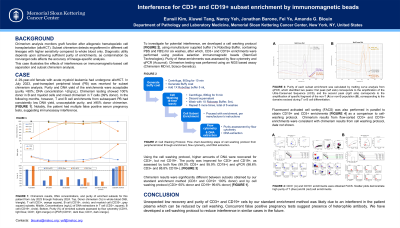Back

(P601) Interference for CD3+ and CD19+ subset enrichment by immunomagnetic beads
Location: Platinum Ballroom

Poster Presenter(s)
Body: Chimerism analysis monitors graft function after allogeneic hematopoietic cell transplantation (alloHCT). Subset chimerism detects engraftment in different cell lineages with higher sensitivity compared to whole blood only. Diagnostic utility depends upon achieving sufficient purity of enrichments, as contamination by non-target cells affects the accuracy of lineage-specific analysis.
This case illustrates the effects of interferences on immunomagnetic-based cell separation and subset chimerism analysis. A 29-year-old female with acute myeloid leukemia had undergone alloHCT. In July 2023, post-transplant peripheral blood (PB) was received for subset chimerism analysis. Purity and DNA yield of the enrichments were acceptable (purity >80%; DNA concentration >2ng/uL). Chimerism testing showed 100% donor in B and myeloid cells and mixed chimerism in T cells (39% donor). In the following months, however, T and B cell enrichments from subsequent PB had consistently low DNA yield, unacceptable purity, and ≥95% donor chimerism. [FIGURE 1]. Notably, the patient had multiple false positive serum pregnancy tests, suggesting immunoassay interference.
To investigate for potential interference, we developed a cell washing protocol [FIGURE 2], using manufacturer supplied buffer (1x RoboSep Buffer, containing PBS and FBS) for six washes, after which, CD3+ and CD19+ enrichments were performed using positive selection immunomagnetic beads (StemCell Technologies). Purity of resulting subsets was assessed by flow cytometry and qPCR (Accumol). Chimerism testing is performed using an NGS based assay (Chimerism MD kit, Scisco-Genetics).
Using a cell washing protocol, higher DNA was recovered for CD3+, but not CD19+. The purity was improved for CD3+ and CD19+, as assessed by both flow (99.3% CD3+ and 95.9% CD19+) and qPCR (98.6% CD3+ and 88.8% CD19+). Chimerism results were significantly different between subsets obtained by our standard enrichment method (CD3+ and CD19+ 100% donor) and by cell washing protocol (CD3+ 65% donor and CD19+ 99.6% donor) [FIGURE 1].
Conclusion: Unexpected low recovery and purity by our standard enrichment method was likely due to an interferent in the patient plasma which can be reduced by cell washing. Concurrent false positive pregnancy tests suggest presence of heterophile antibody. We have developed a cell washing protocol to reduce interference in similar cases in the future.
This case illustrates the effects of interferences on immunomagnetic-based cell separation and subset chimerism analysis. A 29-year-old female with acute myeloid leukemia had undergone alloHCT. In July 2023, post-transplant peripheral blood (PB) was received for subset chimerism analysis. Purity and DNA yield of the enrichments were acceptable (purity >80%; DNA concentration >2ng/uL). Chimerism testing showed 100% donor in B and myeloid cells and mixed chimerism in T cells (39% donor). In the following months, however, T and B cell enrichments from subsequent PB had consistently low DNA yield, unacceptable purity, and ≥95% donor chimerism. [FIGURE 1]. Notably, the patient had multiple false positive serum pregnancy tests, suggesting immunoassay interference.
To investigate for potential interference, we developed a cell washing protocol [FIGURE 2], using manufacturer supplied buffer (1x RoboSep Buffer, containing PBS and FBS) for six washes, after which, CD3+ and CD19+ enrichments were performed using positive selection immunomagnetic beads (StemCell Technologies). Purity of resulting subsets was assessed by flow cytometry and qPCR (Accumol). Chimerism testing is performed using an NGS based assay (Chimerism MD kit, Scisco-Genetics).
Using a cell washing protocol, higher DNA was recovered for CD3+, but not CD19+. The purity was improved for CD3+ and CD19+, as assessed by both flow (99.3% CD3+ and 95.9% CD19+) and qPCR (98.6% CD3+ and 88.8% CD19+). Chimerism results were significantly different between subsets obtained by our standard enrichment method (CD3+ and CD19+ 100% donor) and by cell washing protocol (CD3+ 65% donor and CD19+ 99.6% donor) [FIGURE 1].
Conclusion: Unexpected low recovery and purity by our standard enrichment method was likely due to an interferent in the patient plasma which can be reduced by cell washing. Concurrent false positive pregnancy tests suggest presence of heterophile antibody. We have developed a cell washing protocol to reduce interference in similar cases in the future.

